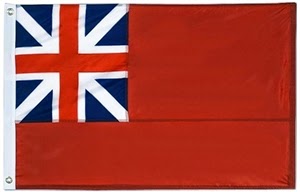By Frank N. Barker
Assistant Education Coordinator
“Resolved that the flag of the thirteen united states to be thirteen stripes alternate red and white, that the union be thirteen stars, white on a blue field, representing a new constellation.” These were the words that the Second Continental Congress used on June 14, 1777, to create the American Flag.
 |
| The Continental Colors, also known as the Grand Union |
 |
| British Red Ensign, flown on merchant ships in the 18th and early 19th centuries. |
This “Continental Colors” flag was first hoisted over a Continental Navy vessel, the USS Alfred in December 1775, by Lt. John Paul Jones, and over the Continental Army at Cambridge, January 2, 1776, by General George Washington.
The resolution of June 14, 1777, that would change these half-British half-American flags into the full-fledged Stars and Stripes does not give much specific information about the flag’s design or proportions. How many points on the stars? How should this “new constellation” be arranged? Does the flag start with white stripes on top or red? Much was left up to interpretation. What did these first flags look like? How were they first used?
 |
| The Bennington flag, which may or may not have flown at the Battle of Bennington. |
 |
| The flag of the Green Mountain boys which did fly at Bennington. |
 |
| The Hopkinson flag, with its six-pointed stars. |
And what of Betsy Ross? While the “Betsy Ross” flag design with the 13 stars in a circle was often used during the Revolution, and is perhaps the modern ideal of what a Revolutionary War flag should look like, she never submitted a design, didn’t meet with the flag committee, or George Washington. Her story only came to light nearly a century after the Revolution and was likely a creation by her grandson William Canby.
Nothing exists from Congress—no law, no executive order, no resolution—that gives an official reason for the colors of the American flag, but Charles Thomson, secretary of the Continental Congress helped design the Great Seal of the United States. In his report to Congress on June 20, 1782, the day the seal was approved he described the colors thusly: “White signifies purity and innocence. Red hardiness and valour and Blue…signifies vigilance, perseverance and justice.”
Sources
Connell, Royal W., and William P. Mack. "Naval Ceremonies, Customs, and Traditions." Google Books. Web. 17 June 2014.
"Flag of the United States." Wikipedia. Wikimedia Foundation, 15 June 2014. Web. 16 June 2014. <http://en.wikipedia.org/wiki/Flag_of_the_United_States>.
"Historical Flags for Sale | Historic American Flags | Historic Flags | Flags Unlimited." Web. 17 June 2014. <http://www.usflags.com/category/9-historical-us-flags.aspx>.
Leepson, Marc. "Five Myths about the American Flag." Washington Post. The Washington Post, 10 June 2011. Web. 17 June 2014. <http://www.washingtonpost.com/opinions/five-myths-about-the-american-flag/2011/06/08/AG3ZSkOH_story.html>.

No comments:
Post a Comment